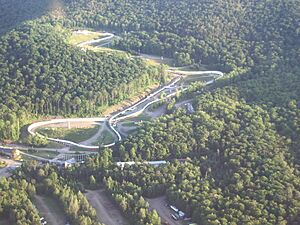Mount Van Hoevenberg facts for kids
Quick facts for kids Mount Van Hoevenberg |
|
|---|---|
| Highest point | |
| Elevation | 2,939 ft (896 m) |
| Prominence | 627 m (2,057 ft) |
| Geography | |
| Location | North Elba, Essex County, near Lake Placid, New York, U.S. |
| Parent range | Adirondack Mountains |
| Topo map | USGS North Elba |
Mount Van Hoevenberg is a mountain in the Adirondack Mountains in New York, USA. It's about 9 miles (15 km) from Lake Placid. This mountain is famous for its sports complex. It has a special track for bobsleigh, luge, and skeleton. There are also many trails for cross-country skiing. Mount Van Hoevenberg hosted events for the 1932 Winter Olympics and the 1980 Winter Olympics.
Contents
Olympic History and Sports
Mount Van Hoevenberg is well-known for its Olympic connections. It was named after Henry Van Hoevenberg, who lived from 1849 to 1918. The mountain's sports complex has been a key site for winter sports.
Hosting the Winter Olympics
The mountain played a big part in two Winter Olympic Games.
- In the 1932 Winter Olympics, it hosted the bobsleigh events.
- For the 1980 Winter Olympics, it was even busier. It hosted bobsleigh, luge, cross-country skiing, and biathlon.
The Olympic Regional Development Authority (ORDA) now manages the sports complex. They take care of the cross-country ski and biathlon trails. These trails were first used in the 1980 Olympics.
Sports Complex Activities
The Mount Van Hoevenberg sports complex offers many activities. It has a special track for bobsleigh, luge, and skeleton. These are fast-paced sliding sports.
During the summer, the mountain is also popular. People come here for fun activities like hiking and mountain biking.
Water Flow and Rivers
Mount Van Hoevenberg is part of a large watershed. This means that all the rain and snow that falls on the mountain eventually flows into certain rivers.
The water from Mount Van Hoevenberg flows into the West Branch of the Ausable River. This river then flows into Lake Champlain. From Lake Champlain, the water travels north into Canada. It goes into the Richelieu River, then the Saint Lawrence River, and finally reaches the Gulf of Saint Lawrence.
The slopes of the mountain direct the water. The southwest side drains right into the West Branch of the Ausable River. The northern and southern slopes send their water into smaller streams. These streams are called North and South Meadow Brooks. They are also tributaries that feed into the West Branch of the Ausable River.


